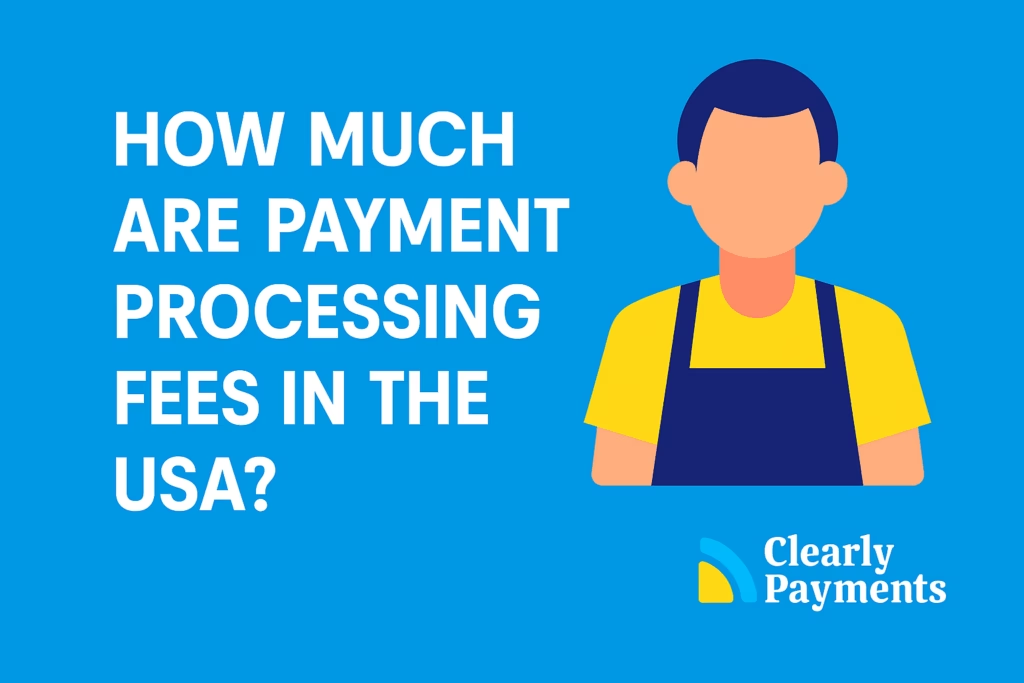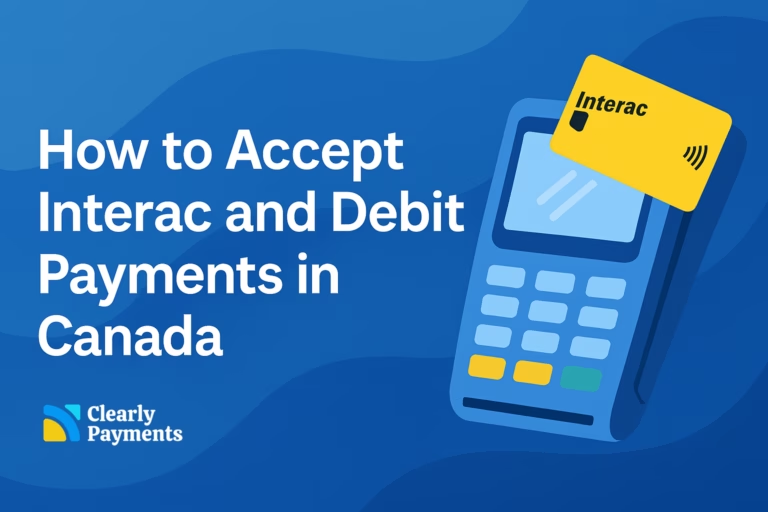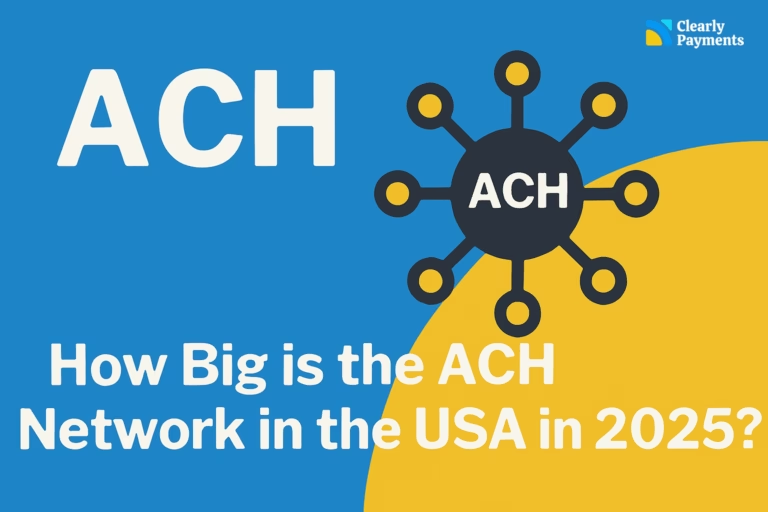Accepting credit cards, debit cards, and digital wallets is table stakes now. In the United States, more than 80 percent of in-store transactions and essentially all ecommerce checkouts involve an electronic payment method, not cash.
The cost to accept those payments is called “payment processing,” and it’s one of the top operating expenses for many merchants, often larger than utilities, POS hardware leases, or even marketing.
This article breaks down what U.S. merchants actually pay, why they pay it, what’s changing in 2025, and how pricing models like flat rate, interchange-plus, and tiered really compare.
Executive summary
- Typical all-in credit card processing cost for a U.S. small business in 2025: about 2.5% to 3.5% of each transaction. That means $2.50 to $3.50 in fees on a $100 sale.
- Some merchants, especially lower-volume or higher-risk businesses, are seeing effective rates above 3.5%, even 4.0% once you include all add-on fees.
- Debit cards are cheaper. Regulated (large bank) debit in the U.S. is capped by the Federal Reserve, roughly $0.21 plus 0.05% of the sale, plus a $0.01 fraud-prevention allowance, which often works out to well under 1% effective cost on typical ticket sizes.
- Premium “rewards” and “elite” credit cards cost merchants the most. Interchange on certain premium Visa restaurant transactions can reach up to ~2.60% before the processor adds anything.
- The pricing model you’re on matters as much as the card being used. Flat-rate is predictable but often expensive; interchange-plus can be cheaper if you have volume and clean risk; tiered pricing is common but often the least transparent.
What Are Payment Processing Fees For?
When you accept a card, several parties touch the transaction in a fraction of a second:
- The issuing bank (the customer’s bank)
- The card network (Visa, Mastercard, Amex, etc.)
- The acquiring bank (the company that takes on the risk and settles funds)
- The payment processor (the company that onboards you, gives you the merchant account)
Your processing cost is made of three main layers:
1. Interchange Fees
The interchange fee is the fee paid to the cardholder’s bank. It’s set by the card networks and is the single biggest cost in most transactions. In 2025, U.S. interchange generally ranges from about 0.5% on low-cost regulated debit up to well over 2% for certain premium credit cards, plus a per-transaction fee.
Example: Visa publishes hundreds of interchange categories. A basic consumer credit card used in-person at a retail store might be ~1.5%–1.7% + $0.10. A high-end “Infinite/World Elite” rewards card at a restaurant can push ~2.6%.
For debit cards issued by large U.S. banks (over $10B in assets), the Fed limits interchange to a cap. Today, that cap is effectively ~$0.21 + 0.05% + $0.01 for fraud prevention.
On a $50 debit sale, that cap works out to:
- Base: $0.21
- % component: 0.05% of $50 = $0.025
- Fraud prevention: $0.01
Total ≈ $0.245, or roughly half a percent of the ticket.
Why it matters: Interchange is mostly not negotiable for a typical merchant. It is set centrally by networks, and in practice, merchants pay it.
2. Assessment or Network fees
These are fees from the card networks themselves (Visa, Mastercard, etc.) paid on every transaction. They’re usually around 0.13% to 0.15%. You can think of this as “the toll to use the rails.”
3. Processor and Acquirer markup
This is what your payment processor (like Clearly Payments) charges to operate your account: authorization, fraud tools, chargeback handling, reporting, settlement, PCI compliance support, etc.
The markup can range from ~0.20% for high-volume, low-risk merchants all the way up to 1.0%+ for higher-risk categories, plus fixed per-transaction fees.
When people say “I pay 2.9% + 30¢,” that bundled price includes interchange, network fees, and processor markup combined.
What are the average payment processing fees in the USA right now?
There is a difference in fees and structure between credit cards and debit cards.
For credit cards
Most U.S. merchants pay somewhere between 2.5% and 3.5% per transaction all-in for standard consumer credit cards in 2025.
Smaller merchants (under ~$1M annual card volume) tend to be toward the high end of that range. They have less negotiating power and typically get “flat” or “tiered” pricing from aggregators or legacy processors. Effective rates of 3.2%–4.0% are not unusual once you include statement fees, PCI “non-compliance” fees, chargeback handling fees, etc.
Larger merchants (>$10M annual volume) often negotiate. It’s common to see effective blended rates closer to 1.5%–2.0% because:
- They get interchange-plus with very slim markups.
- They qualify for lower interchange categories (e.g. Level II / Level III data for B2B, or large-ticket programs).
- They have leverage: card networks and processors will discount to win or keep them.
Merchant Accounts
Card type matters a lot:
- Basic consumer credit (swiped/chip in person): usually in the lower 2%–2.5% effective range for a typical SMB after markup.
- Premium rewards / travel cards: higher, often 3%+ effective for that single transaction because the interchange itself is expensive.
Southwestern Law School - Corporate / purchasing cards in B2B: can actually be cheaper than premium consumer rewards if you pass extra data (invoice number, tax amount, etc.). That extra data qualifies you for special “Level II/III” interchange categories with lower rates.
For debit cards
Debit is usually cheaper than credit in the U.S., especially when the card is issued by a large bank and the transaction is in-person with PIN.
Thanks to Regulation II (the “Durbin Amendment”), those large issuers are capped at $0.21 + 0.05% + $0.01.
Result: It’s very common to see effective debit costs below 1%, sometimes well below, for an average ticket like $30–$60.
However:
- “Signature debit” (where the card is run as credit) can cost more than PIN debit.
- Debit cards from smaller banks and credit unions (under $10B in assets) are exempt from the cap and can be priced more like credit.
In practice, most merchants still quote a single blended rate to themselves (“I pay 2.9% + $0.30”) and don’t see the cheaper debit economics unless they’re on an interchange-plus style program where debit savings actually pass through.
How much does card-not-present / online cost vs in-store?
Online / card-not-present (CNP) transactions almost always cost more than the same card used in person.
Why?
- Higher fraud risk -> higher interchange categories.
- No physical chip read -> networks classify as riskier.
- Processors often add an extra premium for gateway / fraud tooling.
Result: It’s normal for ecommerce and invoice-pay merchants in the U.S. to see 3.0%+ effective rates, especially if they’re small and using a simple “flat” processor.
This is also why many merchants now steer customers toward ACH/bank transfer or “Pay by bank” at checkout. Bank transfer options often run 1.0%–2.0% or even a fixed low fee per transaction, versus 3%+ for cards.
Trends and regulatory pressure
Payment processing fees are under more scrutiny in 2025 than at any point since the original U.S. debit cap in 2011.
Key trends:
1. Interchange pressure and lawsuits
U.S. merchants have argued for years that swipe fees are too high and largely non-negotiable. Visa and Mastercard reached a multibillion-dollar settlement with merchants that will, among other things, lower and cap certain credit card fees for roughly 3–5 years and let merchants steer customers toward cheaper payment types more easily. The settlement is projected to save U.S. businesses tens of billions of dollars over a five-year window.
This is a big deal for smaller merchants, who historically had almost no leverage.
Practical effect for merchants:
- Some categories of credit card fees should come down slightly in the near term.
- You’ll likely see more explicit surcharges (“3% if you pay with credit”) or cash/ACH discounts because rules around steering are loosening.
2. Debit fee reform
The Federal Reserve has proposed tightening the regulated debit cap again, targeting a lower base fee and requiring periodic updates every two years. The idea is to align caps with the actual cost to issue debit cards, which the Fed says has gone down.
If finalized, that would further push debit costs down for merchants, especially on small tickets (coffee, QSR, convenience).
3. State-level and federal proposals
Lawmakers continue to push bills like the Credit Card Competition Act and state-level interchange rules. Some proposals would block networks from charging interchange on sales tax and tips, which would directly cut merchant costs in restaurants and service businesses, but also hit bank revenue.
Banks argue that cutting interchange will mean weaker card rewards and more account fees for consumers. Merchants argue they’re already funding those rewards through high swipe fees. Both sides are lobbying heavily.
4. Shift to premium rewards cards
Consumers love high-end rewards (cash back, travel points). Those cards tend to carry higher interchange fees to fund those perks. That shift in consumer behavior, people pulling out their “platinum travel card” instead of a plain debit card, keeps average merchant costs elevated even as regulators try to cap certain categories.
5. Alternative payment rails
Merchants are quietly steering toward cheaper rails: ACH pay-by-bank buttons at checkout, “cash discount” programs at gas pumps, buy-now-pay-later options with negotiated merchant fees, private wallets inside apps, and even store-branded debit. Many of those methods have effective fees closer to 1%–2%, which undercuts a 3%+ online card transaction.
Bottom line on trends:
- The headline percentage (2.5%–3.5%) is finally getting political attention.
- Debit will likely keep getting cheaper.
- High-end rewards cards probably stay expensive for merchants.
- You’ll see more “Pay by bank and save X%” messaging at checkout.
Pricing models you’ll see as a merchant
The way your processor bills you can make a major difference in your overall cost. In the U.S., four main payment pricing models dominate the market.
1. Flat-Rate (Blended)
| Feature | Description |
|---|---|
| How it works | A single rate (e.g., 2.9% + 30¢) applies to all card types and brands. |
| Pros | • Simple and predictable • Easy for small businesses and online checkouts • No complicated statements |
| Cons | • No benefit from low-cost debit cards • Can be expensive as volume grows |
| Best for | Small or seasonal merchants processing under $250K–$500K per year |
2. Interchange-Plus (Cost-Plus)
| Feature | Description |
|---|---|
| How it works | You pay the actual interchange rate (set by the card network) plus a small markup (e.g., 0.20% + 10¢). |
| Pros | • Transparent: you see true costs • Rewards merchants when customers use cheaper debit cards • Scales efficiently with growth |
| Cons | • More complex statements • Some processors add minor monthly or compliance fees |
| Best for | Established or growing merchants seeking cost savings and transparency |
3. Tiered Pricing
| Feature | Description |
|---|---|
| How it works | Transactions fall into categories: “Qualified” (~1.79%), “Mid-Qualified” (~2.49%), “Non-Qualified” (~3.49% + 20¢). |
| Pros | • Appears straightforward at first • Common among legacy processors |
| Cons | • Poor transparency: few transactions truly “qualify” • Easy for providers to reclassify sales into higher-cost tiers |
| Best for | Older accounts; usually worth switching away from this model |
4. Subscription or Membership + Pass-Through
| Feature | Description |
|---|---|
| How it works | You pay a flat monthly fee (e.g., $99) + interchange at cost + a small per-transaction fee (e.g., 8¢). |
| Pros | • Lowest total cost for high-volume businesses • Simple “wholesale” pricing |
| Cons | • May include minimum volume or annual contract • Monthly fee can be inefficient for low-volume or seasonal merchants |
| Best for | High-volume merchants or those with consistent processing activity |
Which payment processing model is cheapest?
The payment processing model that is cheapest depends on your profile:
- Low volume, high mix of online cards, <$250K/year: Flat rate may be fine. You value “simple and it works” over squeezing basis points. The predictability is worth it.
- Growing brick-and-mortar with lots of debit, or restaurants / retail with steady in-person traffic: Interchange-plus (or subscription + pass-through) is usually cheaper, because you benefit from low-cost regulated debit and standard in-person consumer credit.
- If you’ve been on tiered pricing for years: You’re very likely overpaying relative to what you’d pay on interchange-plus. In many audits, the “qualified” teaser rate barely applies to real-world cards.
- High-risk / card-not-present businesses (online supplements, travel, etc.): You may get quoted higher markups no matter what, because of fraud and chargeback exposure. Still ask for interchange-plus transparency. Even if the markup is higher, at least you’ll see what’s driving cost.
How to lower your payment processing costs
Here are the practical levers U.S. merchants are using in 2025:
- Ask for interchange-plus or cost-plus. If you’re doing a few hundred thousand dollars or more per year, you’ve earned the right to ask. This alone can drop effective cost by 30–80 basis points (0.30%–0.80%) if you’re coming off a generic flat rate.
- Optimize for debit. At the counter, encourage tap/chip debit on lower-ticket purchases instead of premium rewards credit. Regulated debit can be under 1% effective cost, versus 3%+ for a high-end travel credit card.
- Capture better data for B2B. If you invoice businesses, pass Level II/III data (tax amount, invoice ID, etc.). That often qualifies you for lower corporate card interchange and can shave meaningful cost.
- Offer (and advertise) lower-cost payment options. ACH / “Pay by bank,” in-app wallets, or cash discount programs are becoming more common — and recent legal settlements make it easier to steer customers without violating network rules.
- Eliminate junk fees. Review statements for: PCI non-compliance fees, monthly “regulatory” fees, “batch fees,” “gateway access fees,” and similar. Many of these are negotiable or avoidable with the right processor setup.
Switch your processing to Clearly Payments
- Flexible and simple integration options
- Fast funding
- A full set of payment products to accept payment anytime, anywhere
- World-class customer service




